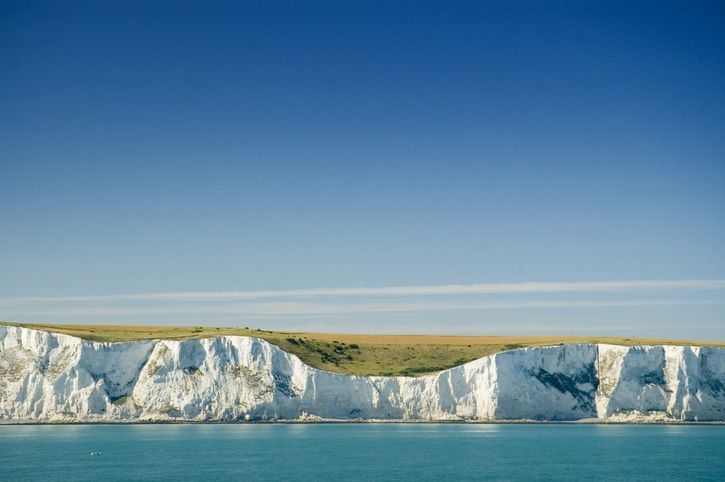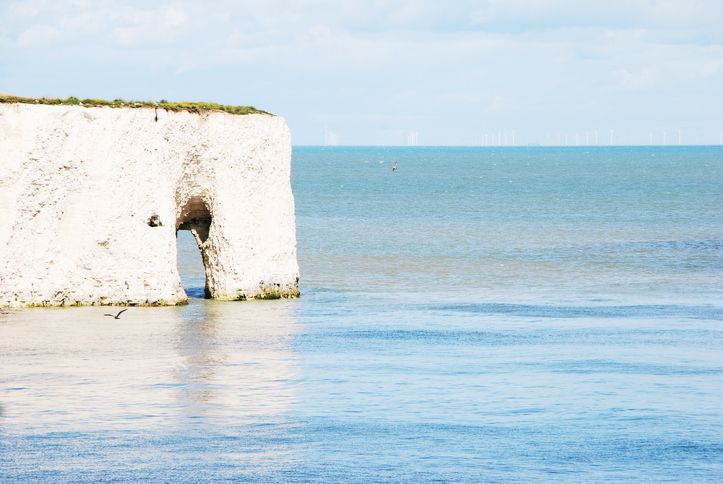White cliffs of Dover viewed from cross channel ferry, Kent, England, United KingdomImmanuel Giel / Creative Commons
Stretching north and south of the harbor town of Dover, the famed White Cliffs lining the Straits of Dover have been to the English for a thousand years the place where home begins.
The White Cliffs flank the port city of Dover with vertical precipices over 300 feet high, a solid wall of gleaming white that extends to both horizons.
It is a spectacular sight; the cliffs seem to rise straight out of the water in a single mass of milk-colored rock, broken only by the narrow gorge into which Dover is jammed. They appear more like a school child’s painting of a cliff than the sloppy reality of an actual cliff.
The Cliffs are symbolic
To the English, the White Cliffs of Dover are not only beautiful, they are also deeply symbolic. The small city of Dover sits closer to mainland Europe than any other port on the island of Britain, a mere 25 miles over the English Channel to the French port of Calais.
When an English soldier went to war, the White Cliffs were his last sight of home; when he returned, the White Cliffs welcomed him to a normal life. They are the very edge of England, the place where home begins and the wide world ends. And they are protection—a defensive barrier that bars enemies from invading.
The Cliffs of Dover
In the 20th century, this protection wore thin. After Germany conquered France in 1940, it assembled an enormous invasion fleet at Calais. The English military lined the cliff tops with defenses they had never before needed—gun emplacements and a network of tunnels and bunkers dug deep into the cliff rock. The 1941 song “The White Cliffs of Dover” expressed this sense of the world turned upside down:
There’ll be bluebirds over the white cliffs of Dover
Tomorrow, just you wait and see.
There’ll be love and laughter and peace ever after
Tomorrow, when the world is free.
The shepherd will tend his sheep, the valley will bloom again,
And Johnny will go to sleep in his own little room again.
The story of the Cliffs
So the White Cliffs have two stories, a nature story and a history story: the tale of a natural wonder of great beauty, and the tale of England’s independence and freedom. As you explore the cliffs, both stories weave in and out before your eyes, creating a tapestry of history and grandeur.
To the right of the cliff, a grassy verge climbs up from the shingle and a set of steps follows it to the cliff top. Those steps are the beginning of a footpath that proceeds along the edge of the White Cliffs for their entire 14-mile length, an easy and well-marked walk over grassy meadows alive with wildflowers. Although the cliffs around Kingsdown are the lowest in the White Cliffs, a mere 150 feet above the sea, the views are spectacular.
The really big cliffs begin at St. Margaret’s Bay. Barely visible on a map as the slightest indent into the cliffs, St. Margaret’s Bay is a small, sheltered cove with a shingle beach. Cliffs jump up instantly on both sides of the shingle, and to its south they just keep rising, reaching 300 feet within a few hundred yards.
Several miles later, the path drops suddenly into Dover, a major port jammed into a narrow gorge hardly more than a quarter-mile wide.
White Cliff Kent off Dover
Dover
From Dover, the cliffs run mainly westward, their bright white wall catching the full southern sun. Now the really tall cliffs begin! Views from the edge are the most breathtaking in the entire length of the White Cliffs, reaching heights of nearly 500 feet.
The drop is completely vertical, and in many places has a substantial overhang. Unfenced and unstable, the edge is a dizzying place, to be approached with the greatest caution. Seagulls glide high above the water—far, far below.
These great, vertical cliffs end five miles west of Dover, and the White Cliffs enter their final phase. Here the top 100 yards of the cliffs have retreated about a quarter of a mile inland, leaving a rough platform perched above the sea. Below the platform are the final 50 feet of cliff, protected by huge sea walls. This is the only place where a walker can follow a safe, marked path straight down the cliff face from top to bottom.
The White Cliffs end on a south-facing hill, covered in short-cropped grass and topped by a Martello Tower—a tall, thick-walled cylinder upon which cannons were mounted to repel any invaders trying to land. The Cliffs of Dover truly are a sight to behold.
* Originally published in June 2018, updated in 2023.





Comments